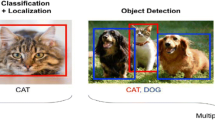Abstract
Moving object detection is an essential component for security video surveillance system and other computer vision applications. Although the latest object detection methods get promising detection expectations, however, accurate detection is still a tricky problem due to various challenges such as aperture effects, illumination variations, camouflage issues and retention problems in unconstrained video environments. In this paper, we propose a brand-new theoretical framework for foreground object detection based on the stable spatial relationship between current pixel and the randomly selected pixels in current frame. Different from the existing methods which determine the moving object area by comparing each pixel value with its surrounding pixels or by comparing two pixel values occupying the same positions in adjacent frames, the proposed algorithm sets up a spatial sample set for each individual pixel and defines Spatial Sample Difference Consensus (SSDC), which denotes changes of stable spatial relationship rather than direct changes in pixel values. Thus, the proposed algorithm computes the SSDC between two adjacent frames to subtract the moving objects. The experiments on recent data-set in both indoor and outdoor surveillance video sequences show that the proposed method achieved promising performance after compared with several state-of-the art methods.









Similar content being viewed by others
References
Brown LM, Senior AW, Tian YL et al (2005) Performance evaluation of surveillance systems under varying conditions[J]. Proceedings of IEEE Pets Workshop pp 1–8
Chen B-H, Huang S-C (2014) An advanced moving object detection algorithm for automatic traffic monitoring in real-world limited bandwidth networks. IEEE Trans Multimedia 16(3):837–847
Goyette N, et al (2012) Changedetection. net: A new change detection benchmark dataset. 2012 I.E. computer society conference on computer vision and Pattern recognition workshops. IEEE
Hu Q, Paisitkriangkrai S, Shen C, van den Hengel A, Porikli F (2016) Fast detection of multiple objects in traffic scenes with a common detection framework[J]. IEEE Trans Intell Transp Syst 17(4):1002–1014
Huang F, Jinqing Q, Lu H, et al (2017) Salient object detection via multiple instance learning.[J]. IEEE Trans image process
Jain R, Nagel HH (1979) On the analysis of accumulative difference pictures from image sequences of real world scenes[J]. IEEE Trans Pattern Anal Mach Intell 1(2):206–214
Jalal AS, Singh V (2014) A framework for background modelling and shadow suppression for moving object detection in complex wavelet domain[J]. Multimed Tools Appl 73(2):779–801
Kalogeiton V, Ferrari V, Schmid C (2016) Analysing domain shift factors between videos and images for object detection[J]. EEE Trans Pattern Anal Mach Intell
Karahan S, Sevilgen FE (2015) CUDA implementation of the pixel based adaptive segmentation algorithm[C]//signal processing and communications applications conference (SIU), 2015 23th. IEEE, 2505–2508.
Kulchandani JS, Dangarwala KJ (2015) Moving object detection: review of recent research trends[C] pervasive computing (ICPC), 2015 International conference on. IEEE, 1–5
Lee G, Mallipeddi R, Jang GJ et al (2015) A genetic algorithm-based moving object detection for real-time traffic surveillance[J]. IEEE Signal Process Lett 22(10):1619–1622
Naqvi SS, Browne WN, Hollitt C (2016) Feature quality-based dynamic feature selection for improving salient object detection[J]. IEEE Trans Image Process 25(9):4298–4313
Noh SJ, Shim D, Jeon M (2014) Background subtraction method using codebook-GMM model. Control, Automation and Information Sciences (ICCAIS), 2014 International conference on. IEEE
Sajid H, Cheung SCS (2015) Universal multimode background subtraction[J]. IEEE T Image Process
Shahbaz A, Hariyono J, Jo K-H (2015) Evaluation of background subtraction algorithms for video surveillance. Frontiers of Computer Vision (FCV), 2015 21st Korea-Japan joint workshop on. IEEE
Subudhi BN, Ghosh S, Nanda PK, et al (2016) Moving object detection using spatio-temporal multilayer compound markov random field and histogram thresholding based change detection[J]. Multimed Tools Appl 1–33
Sun L, Sheng W, Liu Y (2015) Background modeling and its evaluation for complex scenes[J]. Multimed Tools Appl 74(11):3947–3966
Van Droogenbroeck M, Paquot O (2012) Background subtraction: Experiments and improvements for ViBe. 2012 I.E. computer society conference on computer vision and Pattern recognition workshops. IEEE
Wang H, Suter D (2006) Background subtraction based on a robust consensus method. 18th International conference on Pattern recognition (ICPR'06). Vol. 1. IEEE
Wang Z, Wang W (2010) LHMM-based gathering detection in video surveillance. Intelligent Computing and Integrated Systems (ICISS), 2010 International conference on. IEEE
Wang J, Liu P, Liu D-C (2008) The design and analysis of improved adaptive generalized morphological filter. Image and signal processing, 2008. CISP'08. Congress on. Vol. 1. IEEE
Wang X, Wang M, Li W (2014) Scene-specific pedestrian detection for static video surveillance. IEEE Trans Pattern Anal Mach Intell 36(2):361–374
Yang J, Price B, Cohen S, et al (2016) Object contour detection with a fully Convolutional encoder-decoder network[J]. 2016 I.E. Conference on Computer Vision and Pattern Recognition (CVPR) 193–202
Zhang X, Hu HM, Jiang F, Li B (2015) Pedestrian detection based on hierarchical co-occurrence model for occlusion handling[J]. Neurocomputing 168(C):861–870
Zhao L, Tong Q, Wang H (2011) Study on moving-object-detection arithmetic based on W4 theory. Artificial Intelligence, Management Science and Electronic Commerce (AIMSEC), 2011 2nd International conference on. IEEE
Acknowledgements
This work is supported by the National Key Research and Development Plan of China (Grant No.2016YFC0801002), the National Science Foundation of China (No.61370124), the China National 863 Program (Project No. 2014AA015104). The authors would like to express their heartfelt gratitude to all the volunteers in the experiments and the anonymous reviewers, for their help on this paper.
Author information
Authors and Affiliations
Corresponding author
Rights and permissions
About this article
Cite this article
Zhang, C., Zheng, J., Zhang, Y. et al. Moving object detection algorithm based on pixel spatial sample difference consensus. Multimed Tools Appl 76, 22077–22093 (2017). https://doi.org/10.1007/s11042-017-4802-y
Received:
Revised:
Accepted:
Published:
Issue Date:
DOI: https://doi.org/10.1007/s11042-017-4802-y




